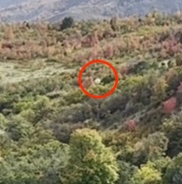Automatic Tracking ML Algorithm
Golf has always been a precision sport, and thanks to contemporary technology, players can now raise the bar on their abilities.
Our cutting-edge machine learning (ML) tracking algorithm enables our newest feature, automatic tracking for discs and golf balls in movies.
Challenges
Unfortunately, standard ML detection approaches are not well-suited for detecting and tracking small objects like golf balls.
Due to the limitations of deep learning neural networks, it is challenging to extract characteristics about objects that are only a few pixels in diameter.
However, our innovative approach overcomes this challenge through a combination of advanced techniques and groundbreaking algorithms.

Example of a video frame

The fragment with the golf ball
Research
We have studied and tried almost every existing ML tracking algorithm including following:
- Standard algorithms from the OpenCV library
- One stage detectors
- Two stage detectors
- Long term trackers
- Short term trackers

Many of these algorithms could not detect or track a golf ball at all, some could only work when both the resolution and the FPS of the video were high enough. In addition to listed algorithms, we have also implemented many ML approaches from scratch, reconstructing the network structure from the paper with research published. Surprisingly, some of them not only don’t provide the source code but also don’t work as described in the paper.
Our solution
After almost a year of rigorous research and experimentation with data and algorithms, we developed the Ace Trace neural network. This network can track golf balls as small as a few pixels in size. Deep learning methods are used by our machine learning detection algorithm to evaluate and categorize images as well as some characteristics of the flying objects. Due to the algorithm’s thorough training on a sizable dataset of golf ball and disc videos, it is now able to recognize and track these objects in videos with high accuracy.
One of the significant challenges in detecting small objects like golf balls is dealing with partial visibility and rapid changes in visual features. Golf balls move at high speeds, resulting in varying lighting conditions from frame to frame. To overcome this challenge, our algorithm utilizes advanced techniques like data augmentation to simulate different scenarios. This makes our technology more resilient and effective in detecting and tracking golf balls than standard ML detection algorithms.
The results of our algorithm are impressive. Golfers can now visualize their shots and share their trajectories previously invisible to the naked eye. Our state-of-the-art machine-learning detection algorithm is a game-changer for golfers and beyond. Our innovative approach, advanced techniques, and adaptability make our technology unique, providing golfers greater precision and insight to take their game to the next level.